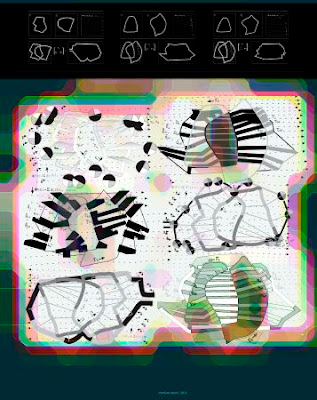Letitzia Bucur si Sherban Epuré sunt doi artisti americani de origine romana stabiliti la New York.
Letitzia Bucur
Vizionarea lucrarilor cu detalii:
Sherban Epure, mathematics for arts
Vizionarea lucrarilor cu detalii:
Sherban Epure :
2008
• Alan G. Artner - Tribune critic The Chicago Tribune, ART REVIEW, January 31,
Feast for the eyes and mind
Computer-generated images began more than 50 years ago
"Imaging by Numbers: A Historical View of the Computer Print," at Northwestern University's Mary and Leigh Block Museum of Art, presents the development of a way of working that grew from the optimism of 1950s mathematicians and engineers and, despite the perpetual clamor for something "new" in the art world, has remained cutting edge. Still, visual complexity remains an unspoken standard, so even when more recent works appear abstruse (Hans Dehlinger, Sherban Epure, Jason Salavon) they feed the eye as well as nourish the mind.
2006
• Bruce Wands, Art in the Digital Era, (London , Thames and Hudson) pp. 10 & 33.
Sherban Epuré uses the term "meta-phorms" to describe the results of his mathematically based image-generating process. This work produced using algorithms, is formed by interaction of colour with a simple geometric shape. One intent of Epuré's imaging is to forge a link between Western technology and Eastern spirituality. page10.
The use of programming to create images continues to the present day, and artist such as Paul Brown (pp. 44-45), Sherban Epuré (p.10), Jean-Pierre Hébert (pp.13,38), Manfred Mohr (pp. 25,63), Michael Trott and Roman Verostko (p.70) all use programming as an integral part of their creative process. ... page33.
2006
• Mihai Nadin. Excerpt from the pre-pubishing review of Epuré's article
"An Artist's Journey in Art and Science: From behind the Iron Court to Present-Day America". Leonardo, the Journal of the International Society for the Arts, Sciences and Technology, October, vol. 39, #5, (the MIT Press, Boston, Ma.) pp.402-409 and 436.
...Sherban Epure is an established artist, with a reputation that makes clear that such an article is useful not as a substitute for the work, but rather as an expression of awareness of the aesthetic process. History and aesthetic testimony contribute to our better understanding of the dynamics of change in art and aesthetic conceptions. Definitely, change came about in a different way in the free world. But art is frequently an expression of intellectual resistance and of an active attempt to make change possible against the odds. In the absence of computers, Sherban Epure conceived his work in the spirit of computation and not as an implementation (through some programs). His algorithms are mental algorithms, well ahead of those later on attempted by the “official” pioniers of computer art. He was ahead of many of those and I believe he still is, in the sense that by now he gained access to computation, but his “output”is art and not medium dependent products.
1996
• Prof. Dr. Georg Nees, (excerpt from a personal letter), Erlangen, Germany.
..." What I admire highly, is your ability to invent innovative canons of form. Your handling of the circle segment not only as syntactic basic element, but your using it as the esthetic skeleton for designing even the human gestalt, this is amazing... So you have found yourself your personal language and writing of form, what is a rare event, I think."...
1996
• Edward Sozanski, The Galleries' Review, The Philadelphia Inquirer, February 16, Philadelphia.
"Epuré, who is also in the Silicon Gallery show, is a pure computer artist, and an unusually imaginative one. His large laser prints express a strong computer-generated personality but they also indicate that Epuré thinks primarily like a painter, ...."
1973
• Jacques Lonchampt, Art and Computer at Sigma of Bordeaux, Le Monde, November 30, Paris.
.."Alongside the fundamental works like Sherban's Epuré analysis of marked outlines which call in mind Leonardo da Vinci's famous drawings books... One can see here the point of contact of an artistic idea in the programmed intersection of two notions."
1971
• Richard Demarco, the catalogue of the 25th Edinburgh International Jubilee Festival at the Richard Demarco Gallery, Edinburgh.
"Epuré is the rare bird, the mathematician and the poet in one."
.
. .
.
.
.
.JPG)
8x20_86.JPG)
12x14_98.JPG)
25x56_98.JPG)








Niciun comentariu:
Trimiteți un comentariu